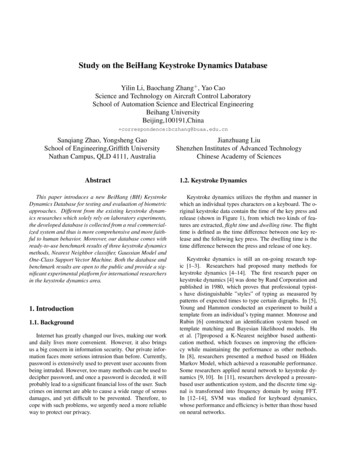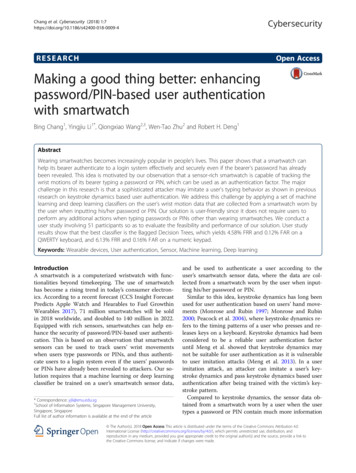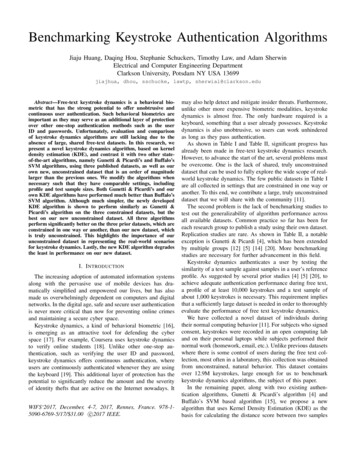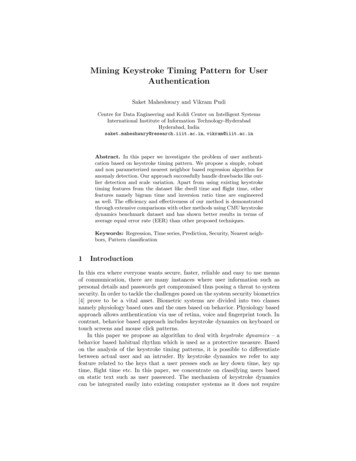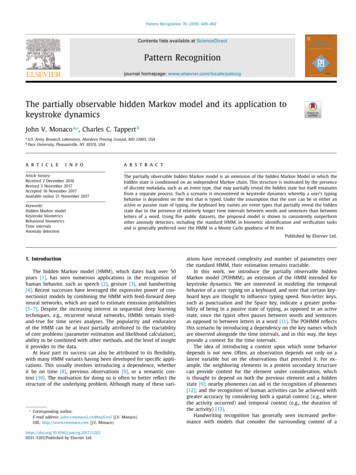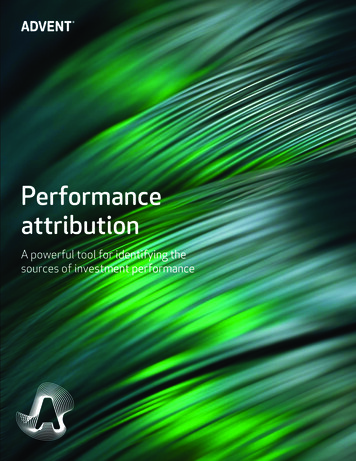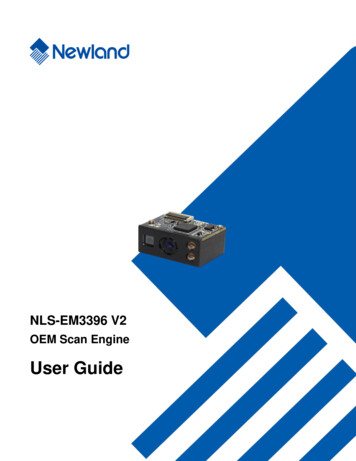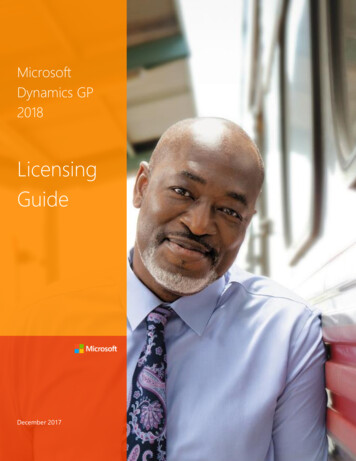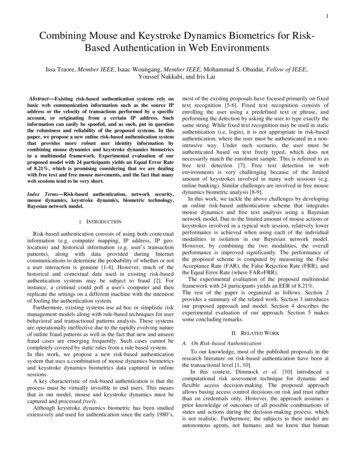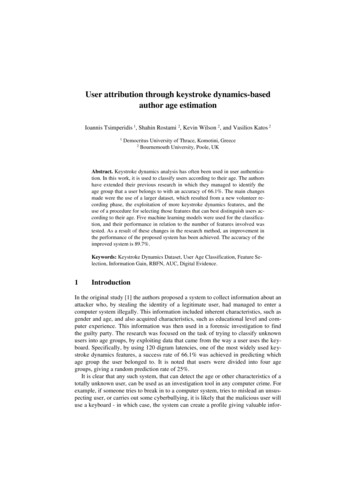
Transcription
User attribution through keystroke dynamics-basedauthor age estimationIoannis Tsimperidis 1, Shahin Rostami 2, Kevin Wilson 2, and Vasilios Katos 21Democritus University of Thrace, Komotini, Greece2 Bournemouth University, Poole, UKAbstract. Keystroke dynamics analysis has often been used in user authentication. In this work, it is used to classify users according to their age. The authorshave extended their previous research in which they managed to identify theage group that a user belongs to with an accuracy of 66.1%. The main changesmade were the use of a larger dataset, which resulted from a new volunteer recording phase, the exploitation of more keystroke dynamics features, and theuse of a procedure for selecting those features that can best distinguish users according to their age. Five machine learning models were used for the classification, and their performance in relation to the number of features involved wastested. As a result of these changes in the research method, an improvement inthe performance of the proposed system has been achieved. The accuracy of theimproved system is 89.7%.Keywords: Keystroke Dynamics Dataset, User Age Classification, Feature Selection, Information Gain, RBFN, AUC, Digital Evidence.1IntroductionIn the original study [1] the authors proposed a system to collect information about anattacker who, by stealing the identity of a legitimate user, had managed to enter acomputer system illegally. This information included inherent characteristics, such asgender and age, and also acquired characteristics, such as educational level and computer experience. This information was then used in a forensic investigation to findthe guilty party. The research was focused on the task of trying to classify unknownusers into age groups, by exploiting data that came from the way a user uses the keyboard. Specifically, by using 120 digram latencies, one of the most widely used keystroke dynamics features, a success rate of 66.1% was achieved in predicting whichage group the user belonged to. It is noted that users were divided into four agegroups, giving a random prediction rate of 25%.It is clear that any such system, that can detect the age or other characteristics of atotally unknown user, can be used as an investigation tool in any computer crime. Forexample, if someone tries to break in to a computer system, tries to mislead an unsuspecting user, or carries out some cyberbullying, it is likely that the malicious user willuse a keyboard - in which case, the system can create a profile giving valuable infor-
2mation to digital forensics agents. Indeed, the need for such a system, or for something similar, is becoming increasingly urgent due to the amount of cybercrime in theworld today [2].In the previous research, some goals were set for further work, including expanding the available dataset, by recording more users during the daily use of their computers, and using multiple classifiers in parallel, the results from which would besummarised with the use of Dempster-Shafer theory [3]. To achieve these goals, athree step plan was developed. First, a new user recording phase took place; second,more features of the keystroke dynamics were utilized; and third, additional classifierswere used.The objective of the project has remained the same, which is to recognize certainuser traits in the most universal and most economical way possible, whilst ensuringthe privacy of the users and minimizing their harassment.The rest of the paper is organized as follows. In the next section, the relevant literature in this and similar fields is summarised. The following section describes the experimental methods used: namely the data acquisition, the selection of suitable features, and the evaluation procedure. Then the results from the use of five well-knownmachine learning models, namely support vector machine (SVM), simple logistic(SL), Bayes classifier (NB), Bayesian network classifier (BNC), and radial basis function network (RBFN), are presented. Finally, the paper concludes by listing the conclusions and plans for further research.2BackgroundClassifying computer users according to their characteristics could be useful in a variety of applications. For example, in automated translation, due to the fact that manylanguages have some system of grammatical gender, a more successful translationmight result when the gender of the user who is typing is known. Another example istargeted advertising, where characteristics such as gender, age and educational levelare important parameters for determining a user’s interests. Yet another example is instrengthening user authentication, where the more user characteristics that can be usedfor comparison, the greater the possibility that the user can be correctly identified.Human-computer interaction applications can also benefit from the ability to recognise user characteristics, as it enables them to modify their interface, and display userspecific messages. Because of these and other applications, the classification of computer users has captured the attention of many researchers.For example, Zhang et al. [4] exploited text features typed by users under differentconditions, such as when writing a new message or responding to someone else'smessage, and tried to classify them according to their gender and age, dividing theminto two age groups. With the help of an LSTM network, they managed to achieve asuccessful prediction rate of 90.8% in gender classification, and 82.3% in age classification. In another paper, Culotta et al. [5] collected data from Twitter user profilesand enriched them with demographic data from an audience measurement company,thus creating their dataset. Using features derived from the association of users with
3other users, such as who the user follows, and text features from the tweets that theywrote, and employing a distantly-supervised regression model, they were able to determine the user gender with an F1 value of 0.87. They were also able to determinethe nationality, out of four different choices, with an F1 value of 0.81, and also thepolitical orientation, out of two political parties, with an F1 value of 0.74.One approach to classifying users is to use features extracted from facial pictures,as in the work of Zhang et al. [6], who extracted features from five points of the face,and then cropped the image in different ways. For each resulting image, they used aconvolutional neural network to perform gender classification, where they achieved asuccess rate of about 91.7%, and smile classification, where they achieved a maximum success rate of about 89.3%. Another attempt is that of Chikkala et al. [7], whoused data from four facial picture databases and divided users into six age groups.Their method was based on the third order four pixel pattern and achieved a 96%success rate in each of the databases they used, surpassing performance over all otheractive methods.Most user classification methods, such as those mentioned above, are based on features that were extracted from users’ photos, videos they appear in, text that theytyped, websites that they visited, or a profile that they maintain in a social network.Of course, each of these methods serves the purpose for which it was proposed. However, with regard to the search for forensic evidence in cases where a cybercrime hasbeen committed, most, if not all, of these methods are considered inadequate.There are several reasons for this. One is that a malicious user will usually try toconceal or misrepresent their identity, and so will not perform any attacks throughtheir genuine social network account, Internet service, or computing system, and sothere will be no available picture of the attacker. Consequently, methods that performuser classification through facial images, or the examination of website traffic, orthrough user profile data, cannot be used for this purpose. Another reason is thatmethods that examine text written by the user, are based on the extraction of the required features from words and other parts of speech, such as digrams and trigrams,from a particular language. This means that these methods have serious limitationswhen they are used to examine text from a different language.An alternative approach, which overcomes the aforementioned problems, is to usekeystroke dynamics, a field of computer science that studies how users type. Theadvantage of keystroke dynamics information is that it uses features from the simplestand most common form of communication between Internet users, which is text [8].Users write emails, send instant messages, make searches in search engines, uploadposts, and communicate much more frequently with text than any other method ofcommunication, such as videoconferencing. Another advantage of using keystrokedynamics information is that no special equipment is required for their operation,except for the common QWERTY keyboard. The advantages include the nondisturbance of users as data can be collected during their daily use of the computerwithout requiring additional actions on their part, and independence from the typedlanguage since the features are not related to words in a particular language.In the past, keystroke dynamics information has been used primarily to authenticate users in order to replace or enhance user authentication by passwords.
4Salem and Obaidat [9] proposed an authentication system for Android mobile devices using temporal features such as digram latencies, and non-temporal featuressuch as on-screen pressure, finger positioning, etc. They created an application forrecording volunteer’s actions and as well as that data, they also used and existingdataset for their experiments. Various classifiers were tested, and MLP, with an EERof 0.9%, proved to be the one with the best performance. In another paper, Saini et al.[10] attempted to authenticate users of portable devices, regardless of their body posture when they use them. They recorded data from mobile phones with users sitting,walking, or relaxing. In the processing, the random forest and kNN classifiers wereused, achieving an optimal EER of 4.3%.As has already been mentioned, most of the research on keystroke dynamics hasfocused on authenticating users, with only a small percentage being oriented to otherapplications, such as Kolakowska's work [11], which attempts to recognize the emotional state of a keyboard user. A small amount of the research is concerned withclassifying users according to some of their characteristics, such as the research ofTsimperidis et al. [12], in which the authors collected 242 logfiles from volunteersduring daily use of their computers, used a combination of an RBFN classifier and aboosting algorithm, and managed to predict correctly the educational level of a user,among five options, with accuracy of 86.8%. In another paper, Brizan et al. [13] useddata from 350 volunteers who typed a short piece of text, extracted textual and keystroke dynamics features, and achieved recognition of a user's mother tongue, gender,and handedness, at rates higher than those of random selection.Regarding the classification of users according to their age with the help of keystroke dynamics, which is the subject of this research, there are some interesting studies. Buriro et al. [14] tried to investigate the possibility of estimating, among otherthings, the age of a user who types a PIN/password between 4 and 16 digits in length,on a smart mobile device. They collected their data from 150 volunteers on a specificdevice and defined 3 age groups. They extracted temporal keystroke dynamics features and used Naïve Bayes, SVM, Random Forest, MLP, and Deep Neural Networkfor classification. The best results came from Random Forest (RF), which had anaccuracy of 87.9%. Random Forest was also the most successful classifier amongst 7others, in the work of Roy et al. [15]. They conducted their study to protect youngpeople from unknown threats coming from the Internet and therefore divided usersinto two classes, children and adults. They used three fixed text datasets from 11 to 14keystrokes and exploited keystroke durations and digram latencies. Finally, using anAnt Colony Optimization (ACO) technique they achieved an accuracy of 92.2%. Pentel [16] divided the users into 6 groups, gathered data from more than 7,000 users,each of which was recorded for about 320 keystrokes, extracted 134 keystroke dynamics features in total, and reached an accuracy of 61.6% using Random Forest.It is understood that a number of researches have aimed at classifying users basedon one or some of their characteristics taking advantage of various types of data, suchas face images and posts on social networks. However, only a very small portion ofthem use data derived from keystroke dynamics. This research is one of the few inuser classification through keystroke dynamics and as far as we know the only onethat focuses on the exploitation of results in digital forensics.
53MethodThe methodology consists of three consecutive phases. In the first phase, free-textdata was collected from volunteers who agreed to participate in the experiment. In thesecond phase, a feature selection algorithm was used to sort the features according tothe information that they contain. In the third phase, an attempt was made to determine the previously unknown age of a user by training and hyperparameter-tuningfive well-known machine learning algorithms, namely SVM, Simple Logistic, NaïveBayes, Bayesian Network, and RBFN.3.1Keystroke Dynamics DatasetIt was stated that one of the ways of improving the results of the previous researchwas to extend the available dataset. It was decided that the acquisition of data shouldbe done in a way that interferes as little as possible with the daily use of the computerby the users. For this reason, the keylogger was designed to record actions on thekeyboard, in any application, without causing any harassment to the user.Although the research did not intend to capture the text written by a user, it wastechnically possible to reconstruct it from the data that was recorded. For this reason,guarantees were given to the volunteers who participated, in order to safeguard theirsensitive or personal data, such as passwords, credit card numbers, or messages tothird parties. Each volunteer was given a signed consent form by the researchers,stating that the recorded data would be encrypted, remain exclusively in their possession, and would not be shared with others in any way. It also stated that only the keystroke dynamics features would be studied, from which it would not be possible toreconstruct the original text. In addition, volunteers were not only made aware of thepotential dangers, they were also given the ability to run the keylogger only whenthey wanted to, so that they could choose which data was recorded. Finally, they wereallowed to oversee the data recorded, and decide at any point in the process whetheror not they wished to hand it over to the researchers.Each keyboard action made by the volunteers was recorded in the logfiles, asshown "73,#2017-11-14#,56861883,"up"Each logfile entry consists of four parts separated by commas and corresponds to akey press or release action. The first part is the virtual key code of the key used (from1 to 255); the second part, delimited by the sharp character (#), is the date on whichthe action took place; the third part is the exact time at which the action took place, asan integer denoting the ms that have passed since the beginning of the day (12:00
6am); and finally the fourth part shows the type of action, with "dn" representing a keypress, and "up" representing a key release.With these additional measures, and using the software developed for this purposein the previous study, the researchers conducted a second phase of data collectionfrom volunteers who did not participate in the first phase. The second recording phaselasted 8.5 months, from 24/10/2017 to 09/07/2018, and 43 volunteers were selected,thus increasing the number of participants to 118, so that the demographics of thecreated dataset reflected those of the world population, such as ensuring that the number of males is approximately equal to the number of females, and that the number ofright-handed users is about 90% of the sample [17], and most important for the present study, to have satisfactory representation of all age groups.Table 1 shows the comparison between the initial dataset (first phase of volunteerrecording) and the extended dataset (first and second phases of volunteer recording).Table 1. Comparison between initial and extended dataset.AgeGroup18-2526-3536-4546 TotalInitial DatasetNumberPercentageof Files3213.4%10242.7%9037.6%156.3%239Extended DatasetNumberPercentageof Files9624.8%12933.3%11730.3%4511.6%387As can be seen from Table 1, the expansion of the dataset led to a more even distribution across the age groups, as the logfiles from “18-25” and “46 ” age groups, whichwere the least common in the initial dataset, increased in number so that their share ofthe overall dataset almost doubled in percentage terms.Each of 387 logfiles is between 170 KB and 271 KB in size and contains data relating to between 2,800 and 4,500 keyboard actions. This variation in the size of thelogfiles is due to two things: the fact that the keylogger was designed to record data ofa certain size in bytes, and therefore, depending on the time of the day the volunteerwas recorded, and depending on the keys used, the number of recorded keys couldhave a difference of 5%. The other fact is that, as stated in the consent form, no volunteer was obliged to complete the recording process, which sometimes created filesof smaller than normal size. Eventually, it was decided that only files exceeding acertain size threshold size would be accepted.3.2Feature Extraction and Feature SelectionKeystroke dynamics encompass a large number of features, which can be divided intotwo categories: temporal and non-temporal. The temporal features are the most widely used, and they include keystroke durations and digram latencies. Other features inthe same category are the trigram, tetragram, and general n-gram latencies; the dura-
7tion of pauses during typing; and the typing rate (words per unit of time). The nontemporal features include the percentage use of duplicate keys (“Shift”, “Ctrl”, digits,etc.); the way in which the typing errors are corrected (“Delete”, “Backspace”); andthe time of the day the user is typing.Much of the research involving keystroke dynamics only makes use of a smallnumber of the available features, with most researchers only using some of the keystroke durations and one or more of the digram latencies (down-down, down-up, updown, and up-up). In the first phase of this research, the authors made use of 120down-down digram latencies, which were selected according to their incidence.In this extension to that phase of the research, the intention is to use more keystroke dynamics features and to evaluate them according to the amount of informationthat they provide for classifying users according to their age. However, the featuresexamined will include those found in most researches, namely the keystroke durationsand down-down digram latencies. There are a large number of these, since n2 n features can be extracted from a keyboard with n keys. Most companies use the PC keyboard with 104 keys as a de-facto standard and therefore the number of extractedfeatures can be as large as 10,920.This large number of features can lead to systems with high time complexity andtherefore a procedure must be followed to reduce their number. This process, which iscalled feature selection, must identify those features which are most capable of distinguishing users according to their age. One way of doing this is to calculate the information gain (IG) of each feature f, which is the measure that illustrates the ability ofthat feature to reduce the entropy of a system x. It is expressed as:IG(x, f ) H (x ) H (x f )(1)The entropy H(x) of the system x is given by:mH (x ) P(xi ) ln P(xi )(2)i 1In Equation (2), m is the length of vector x, which in the classification problem is thenumber of classes, and P(xi) is the probability of class xi. In this study there are 4classes and therefore the entropy of the system is 1.312. The term H(x f) is calculatedby dividing the dataset into groups according to the value of the particular feature f.Then, the entropy of each group is calculated and H(x f) is given by:H (x f ) 1 k n j H (x j )N j 1(3)where N is the number of instances of the initial dataset, k is the number of groupsthat the initial dataset was divided into, nj is the number of instances of the j-th group,and H(xj) is the entropy of the j-th group, which can be calculated from Equation (2).This procedure is also described in the work of Osanaiye et al. [18] and, if appliedto every extracted feature in the age classification problem, it will produce a list with
8the amount of information that every feature carries. A list of 15 features with thehighest IG is shown in Table 2, where the keystroke durations are represented withone number (such as "69", the first in the list) and digram latencies are representedwith two numbers, separated by a dash (such as "65-32", the second in the list).Table 2. Keystroke dynamics features with the highest IG in age -327088IG0.06590.06370.06200.06180.0592As can be seen in Table 2, keystroke durations appear to play a more important rolethan digram latencies in user classification based on their age.3.3Experimental Procedure and Validation of ModelsThe feature selection procedure used showed that more than 90% of the features extracted contain zero IG, so they may be excluded from user classification, resulting ina huge reduction in time complexity with a minimal or no reduction in accuracy.The other features, those with non-zero IG, were all used to predict the unknownage of a user. Various classifiers were tested for this purpose, several of whichshowed very low success rates, such as Random Forest, C4.5, k-Nearest Neighbors,Random Tree, and OneR, while others had a prohibitively long training time, such asthe MLP, which was the classifier used in the previous research of the authors. Thefive models that presented high accuracy and low time complexity were SVM, SL,NB, BNC, and RBFN, and therefore the experimental process continued with them.The model validation stage is to ensure that the implementations of the models arecorrect and work as they should. There are many techniques that can be utilized toverify a model and several of them were adopted to validate the five models.First, to assess the performance of the models fairly, we use the 10-folds crossvalidation method. This divides the data into 10 disjoint parts, uses 9 of them fortraining and the remaining one for testing, in a round-robin fashion. In this studywhere the dataset consists of 387 log files, each fold will consist of 38 or 39 files.Second, in order to evaluate the effectiveness of the feature selection procedure,the F-score was also used as a combined measurement of precision and recall, because accuracy alone cannot give the full picture of the overall performance of amodel when classes are imbalanced, and also because the F-score is a measurement ofhow balanced the prediction is between classes.Finally, in order to assess the ranking ability of the classifiers, use is made of thereceiver operating characteristic (ROC) curve, which shows recall as a function of theprobability of a false negative, which is equivalent to 1 – precision. The area under
9the ROC curve (AUC) or ROC index [19] was used. The ROC curve is limited to theinterval [0, 1] in both dimensions, thus the AUC varies between 0 and 1.4Experiments and ResultsFor each of the five models (SVM, SL, NB, BNC, and RBFN) several experimentswere conducted to find the classifier parameters that implement the system with theoptimal performance for different sets of features. The first criterion was the performance with the highest accuracy (Acc.), with the second being the one with the lowest time complexity (TBM - Time to Build Model), followed by the highest AreaUnder the ROC Curve (AUC) and the highest F-score (F1).Experiments were done with various sets of features in order to evaluate the performance of these models. These involved using different numbers of keystroke dynamics features, starting with the first 100 features according to their IG value andfinishing with 700 features, in steps of 100.The best performance of SVM for different number of features, along with the optimal C value, is shown in Table 3.Table 3. The performance of SVM over different number of features# ofFeats.100200300400500600700Statistical .8610.8640.851Classifier al conclusions can be drawn from Table 3. First, the accuracy and the F-score, ineach different set of features, exceeds the corresponding measures of the same classifier in the previous study, which was 56.5% and 0.545 respectively. Second, as expected, time complexity is too low, even when several features are involved. Third,the polynomial kernel works better than the other kernel types.Similarly, Table 4 shows the performance of SL and the corresponding optimalvalues for the last iteration of LogitBoost, over the seven different feature sets, if nonew error minimum has been reached.Table 4. The performance of SL over different number of features# ofFeats.100Statistical ValuesAcc.63.1%TBM0.56AUCF10.8260.625Classifier ParametersLastWeightIterationTrimming5095%
00%85%95%95%100%100%From Table 4 it follows that the Simple Logistic model shows better accuracy and Fscore than the corresponding classifier in the prior study, which were 55.7% and0.552, respectively.The results for the NB classifier are in Table 5.Table 5. The performance of NB over different number of features# .6700.6730.6600.6600.660Two findings from Table 5 are that the Naïve Bayes model shows improved accuracyand F-score in each set of features, compared to the previous research, which produced the values 50.2% and 0.488 respectively, and that, as expected, the time complexity of the model is very low.The best results for BNC are shown in Table 6, which also presents the corresponding optimal initial count on each feature set for estimating the probability tablesand the optimal maximum number of parents of each node in Bayes network.Table 6. The performance of BNC over different number of features# ofFeats.100200300400500600700Statistical 7Classifier ParametersInitialMax NumberCountof Parents0.1050.1030.2030.0110.0210.0110.011
11Table 6 reveals the seemingly contradictory result that the BNC presents higher timecomplexity when the number of features involved is smaller, which is due to the different settings of the classifier that led to its best performance in each case. The BNCmodel was not examined in the previous work and no direct comparison can be made.Finally, the results from the optimal configuration of RBFN in terms of the numberof clusters for K-Means and the minimum standard deviation for the clusters yieldingthe best performance, are presented in Table 7.Table 7. The performance of RBFN over different number of features# ofFeats.100200300400500600700Statistical 2Classifier Parameters# ofMinClustersStd Dev1301.11101.11101.41201.21101.41101.21101.2As can be seen from Table 7, the RBFN presents the best performance for each set offeatures at similar values of the classifier's parameters, namely a value between 110and 130 for the number of clusters for K-Means, and a value between 1.1 and 1.4 forthe minimum standard deviation for the clusters. The RBFN model was also not considered in the previous study.4.1Evaluation and Comparison of ResultsThe best performance of each of the examined models is illustrated in Figure 1.
12Fig. 1. Comparison of the best performances of the five modelsAs can be seen, the RBFN model outperforms all other models in terms of accuracy,AUC, and F-score. SVM follows as second in accuracy and F-score, but also lagsbehind SL and BNC in AUC. NB ranks last out of the five models in performance,but is the fastest of all, along with the BNC.The accuracy of the five models, against the number of keystroke dynamics features used, is shown in Figure 2.Fig. 2. Accuracy of five models on various feature setsIt can be seen from Figure 2 that RBFN presents the highest accuracy against all othermodels, regardless of the feature set, whereas NB presents the lowest. Also, the performance of BNC has the least dependence on the number of features used, as itsaccuracy is 68% 2% regardless of size of the feature set. One last point is that eachof
Keywords: Keystroke Dynamics Dataset, User Age Classification, Feature Se-lection, Information Gain, RBFN, AUC, Digital Evidence. 1 Introduction In the original study [1] the authors proposed a system to collect information about an attacker who, by stealing the identity of a legitimate user, had managed to enter a computer system illegally.
